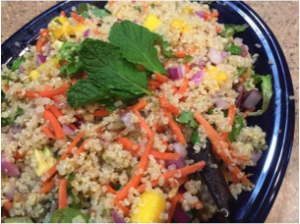 Inflammation is a necessary and important process that happens in the body. The redness, heat, and swelling that happen during injury are a protective response; a response that is designed to quickly repair and heal an injury. The body’s innate intelligence drives this necessary process. However, when inflammation isn’t quick, and targeted, it can cause a state of chronic inflammation leading to disease.
Inflammation is a necessary and important process that happens in the body. The redness, heat, and swelling that happen during injury are a protective response; a response that is designed to quickly repair and heal an injury. The body’s innate intelligence drives this necessary process. However, when inflammation isn’t quick, and targeted, it can cause a state of chronic inflammation leading to disease.
Chronic inflammation has recently been in the spotlight as the root cause of many diseases, such as heart disease, cancer, obesity, and diabetes. Chronic inflammation occurs when your body receives on-going stress signals that activate the immune system to continue producing inflammatory chemicals. This can occur for a number of reasons including poor dietary choices, high stress levels, obesity, low-grade infections and more. The problem is, you don’t know this is happening and there is no blood test for chronic inflammation. But, with heart disease and cancer being the top two causes of death in the United States, it is in our best interest to address the underlying causes of inflammation.
The underlying cause of inflammation isn’t always apparent, however, dietary choices definitely impact the inflammatory status of the body. Common foods like refined sugar, refined grains, industrialized animal products, packaged foods, and baked goods, can promote increased inflammation in the body. In contrast, foods that are high in omega-3 fatty acids, vitamins, minerals, phytonutrients, and antioxidants, help combat the inflammatory burden in the body.
Omega-3 rich foods are important because the body cannot make Omega-3, it must come from the diet. Omega-3 fatty acids are important in combating a number of illnesses including high cholesterol, heart disease, and dementia. Some foods high in omega-3 fatty acids include:
- Sardines
- Salmon
- Flax seeds
- Hemp seeds
- Chia seeds
- Hazelnuts
- Walnuts
Eating foods rich in vitamins, minerals, phytonutrients, and flavonoids also helps decrease inflammation in the body. These nutrients can be found in most fruits and vegetables. It is important to include as many colorful foods in your diet as possible to get a wide variety of disease fighting, age-defying antioxidants. The goal should be to “eat a rainbow” of foods every single day.
Spices also have unique compounds that support a proper inflammatory response. There are many benefits of common culinary spices, but some of the healthiest, antioxidant rich spices include:
- Turmeric: Contains curcumin, one of the most potent anti-inflammatory constituents found in foods. Turmeric is used medicinally to help with joint pain, support healthy cholesterol levels, prevent dementia, and more (1).
- Ginger: In the same family as turmeric, contains gingerol which also promotes a healthy inflammatory response and may explain how ginger helps with pain from osteoarthritis and rheumatoid arthritis (2).
- Rosemary: Contains anti-inflammatory rosmarinic acid. This herb has been used for centuries to improve memory and circulation (3).
- Garlic: Contains sulfur, an important compound for supporting detoxification pathways in the liver. Constituents in garlic also promote decreased inflammation in the heart and blood vessels (4).
Food is a primary tool that can be used to combat inflammation every single day. By including anti-inflammatory, antioxidant rich foods in your daily diet, you have the ability to influence the overall inflammatory burden in the body with each bite you take. Check out the recipe below that incorporates many of these anti-inflammatory principles in one dish.
Summer Quinoa Salad
Ingredients:
1 cup dried quinoa, rinsed well
½ red onion, finely chopped
1 cup carrot, finely chopped
Juice of 1 lime
1 tablespoon extra-virgin olive oil
1 large mango, chopped
¼ cup mint, finely chopped
1 teaspoon sea salt, to taste
Freshly ground black pepper, to taste
½-inch-piece ginger, finely chopped
1 avocado, chopped or thinly sliced
1 cup cashews, coarsely chopped (optional)
3 cups Romaine lettuce (or greens of choice), roughly chopped
Directions:
- Cook the quinoa: Bring 2 cups of water to a boil in a medium saucepan; add the quinoa and simmer, covered 15-20 minutes. Set aside and let cool.
- In a large bowl toss the chopped red onion and carrots.
- In a separate bowl, whisk together the lime juice and olive oil. Add to the onion and carrots.
- Add the cooked, cooled quinoa and mango to the large bowl and toss well.
- Mix in mint, cilantro, ginger and salt and pepper, to taste.
- Garnish with sliced avocado.
- Scoop mixture over greens and serve chilled or at room temperature.
References:
- “Turmeric.” World’s Healthiest Foods. Whfoods.com.
- “Ginger.” World’s Healthiest Foods. Whfoods.com.
- “What Is Rosemary Good For?” Mercola.com.
- “Garlic.” World’s Healthiest Foods. Whfoods.com.
 About the Author: Tonya Mulvaney is a student in the naturopathic medicine program at the National College of Natural Medicine, in Portland, OR, where she is also studying whole-food nutrition and expanding her knowledge in integrative medical research. Her current research is centered around auto-immune diseases and the impact diet and lifestyle have on the immune system. Upon graduation, she plans to return to her hometown of Fargo, and practice as a naturopathic doctor and nutrition educator.
About the Author: Tonya Mulvaney is a student in the naturopathic medicine program at the National College of Natural Medicine, in Portland, OR, where she is also studying whole-food nutrition and expanding her knowledge in integrative medical research. Her current research is centered around auto-immune diseases and the impact diet and lifestyle have on the immune system. Upon graduation, she plans to return to her hometown of Fargo, and practice as a naturopathic doctor and nutrition educator.

